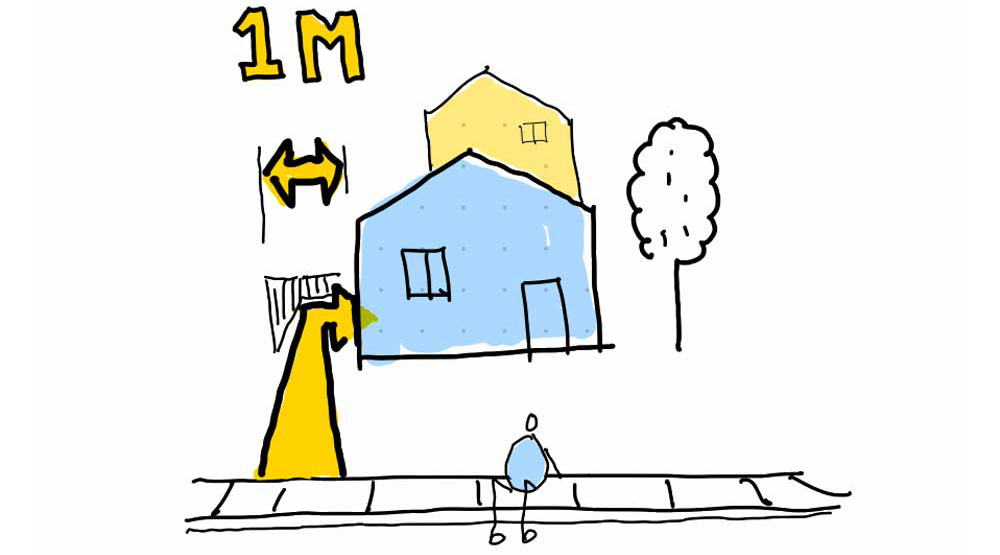This website is a guide and is not intended to replace professional advice. Please see our disclaimer for more information!
Feasibility Check
Garden Suite


These units are created by building an external, detached suite at the rear of a detached home, semi detached home, or townhome. The City of Toronto has specific references and performance standards that all garden suites must follow.
Click here to learn more.
Before you review the information provided by the Ontario website guide, check out our checklist below as a starting point to see if your home is a candidate for this kind of new suite.
Remember to verify all code requirements with your local code, or hire a professional to do this for you!
Before you review the information provided by the Ontario website guide, check out our checklist below as a starting point to see if your home is a candidate for this kind of new suite.
Remember to verify all code requirements with your local code, or hire a professional to do this for you!
Spatial Requirements
Ensure proper access
Check for access to the backyard
You need a minimum of 1m of clear passageway between a house and the edge of a lot for servicing and emergency access to the rear of the unit.
If the lot backs onto a laneway this can be used as an alternative to the 1m clear pathway from the front yard.


Check for protected trees
Are you in an area protected by the Ravine and Natural Features By-law? Check here.
Are there any trees over 30cm in diameter?
If your answer is yes to either of these questions, the trees require protection. Look up the required dimensions for the required Tree Protection Zone around each tree. New construction should stay out of this zone, otherwise you will need to apply for a permit to injure or remove your tree.
You can find more information on tree protection zones, and permits for injuring or removing trees on the city’s website.

Measure the distance between the back of the house and the rear of the lot
Remember you need to maintain a space between a garden or laneway suite and the back of the house.
- 5m for a one story suite
- 7.5m for a two story suite
You will also need to check the required rear yard setback for the laneway suite.
Subtract these setbacks from that number to check if you have enough space. in order to have a viable depth for a new unit you need at least 3m of space for your suite.

Electric, Heating/Air, and Plumbing
Check your utilities
Check your electrical service
Step 1 - Check the existing electrical service on your electrical panel
Find the circuit box. Find the main cut-off switch—this is typically the biggest switch in the box. The cut-off switch often has the number of amps written on it. You will likely need a minimum of 100 amps.
Step 2 - Use the chart below to calculate the existing electrical capacity (Coming soon.)
Step 3 - Check how many units you can add based on the existing electrical capacity. (Coming soon.)
Verify the level of electrical service you will need with a licensed electrical engineer or electrician.

Cost Considerations
Whenever you are deciding what type of unit to add, it is important to understand what the major cost considerations will be. For a garden suite these include:
- unit access
- new construction
- site work
- connections to main home (plumbing/electrical/communications)
- new construction
- site work
- connections to main home (plumbing/electrical/communications)
Case study
The garden suite case study involves adding a distinct living unit in the rear yard, completely separate from the existing structure of the house. This case study replaces an existing detached garage with a two-storey accessory dwelling. Access to this unit exists via the side yard of the site. Major considerations include allowable building area, construction implications, and connections to the main house and beyond (plumbing, electrical, communications, etc.).
Existing Floor Plan



THIS WEBSITE, INCLUDING ALL DATA AND INFORMATION INCORPORATED HEREIN, IS BEING PROVIDED FOR INFORMATION PURPOSES ONLY AND IS NOT INTENDED FOR AND HAS NOT BEEN APPROVED FOR USE FOR CONSTRUCTION AT ANY LOCATION.
For certainty, ReHousing (Canada), The University of Toronto, John H. Daniels Faculty of Architecture Landscape and Design, and LGA Architectural Partners provides no representation or warranty regarding any use of or reliance upon this website, including any representation or warranty that this website complies with applicable laws (including any applicable zoning by-laws or building code requirements) and any representation or warranty that any cost estimates included in or based upon this website have been validated by the applicable market. Any use of or reliance upon this website by any person for any purpose shall be at such person’s sole risk and ReHousing (Canada), The University of Toronto, John H. Daniels Faculty of Architecture Landscape and Design, and LGA Architectural Partners shall have no liability or responsibility for any such use of or reliance upon this website by any person for any purpose. Prior to any use of or reliance upon this website by any person for any purpose, consultation with a professional architect duly licensed in the applicable jurisdiction is strongly recommended.
For certainty, ReHousing (Canada), The University of Toronto, John H. Daniels Faculty of Architecture Landscape and Design, and LGA Architectural Partners provides no representation or warranty regarding any use of or reliance upon this website, including any representation or warranty that this website complies with applicable laws (including any applicable zoning by-laws or building code requirements) and any representation or warranty that any cost estimates included in or based upon this website have been validated by the applicable market. Any use of or reliance upon this website by any person for any purpose shall be at such person’s sole risk and ReHousing (Canada), The University of Toronto, John H. Daniels Faculty of Architecture Landscape and Design, and LGA Architectural Partners shall have no liability or responsibility for any such use of or reliance upon this website by any person for any purpose. Prior to any use of or reliance upon this website by any person for any purpose, consultation with a professional architect duly licensed in the applicable jurisdiction is strongly recommended.





